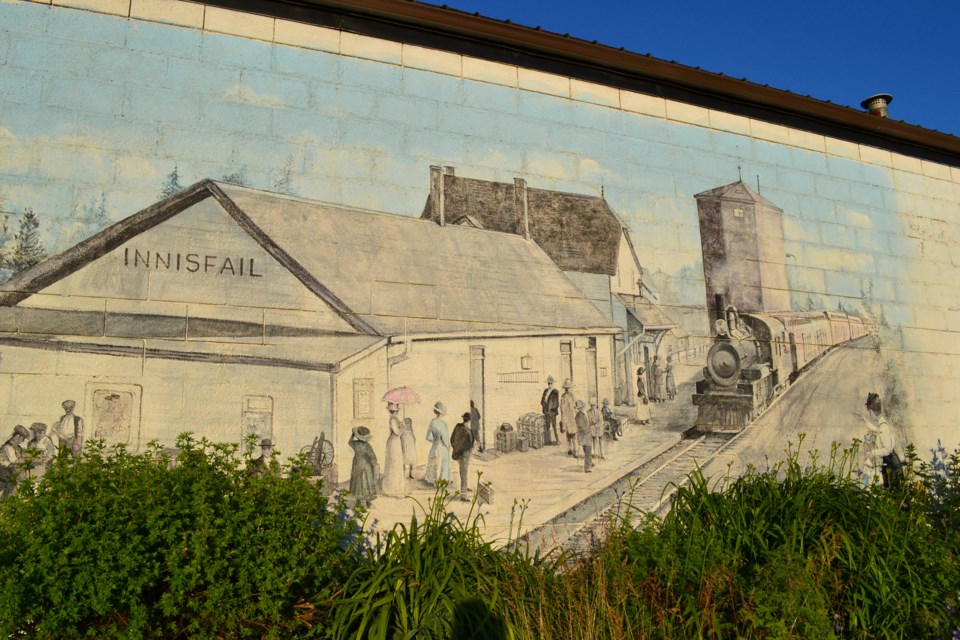INNISFAIL — Town council has finally taken a first hard look at what a long-awaited Public Art Policy could look like for Innisfail.
And it will likely mean the creation of an advisory committee of volunteers to oversee a future public art program, as well as a sustainable funding source, such as an annual capital construction cost allocation of about one per cent.
Council had its first look of a potential Public Art Policy at its Agenda & Priorities Meeting on May 16th when Meghan Jenkins, director of community services, introduced a report to council that gave an overview of potential approaches to establishing a policy and program.
The idea of a Public Art Policy goes back to at least late 2017 when a publicly funded downtown mural that was created in 2003 to honour the town’s 100th anniversary was partially obscured by the construction of a new downtown mall. Two years later the mural was painted over.
In the summer of 2019, the Tribute to the Railroad mural on the west side of the Innisfail Bowling Lanes building was also painted over.
In both cases, town council was told by administration it had "no involvement at all" in the mural removal process, adding it was the sole decision and legal right of private property owners.
Jenkins’ report to council was delivered just a few weeks before two major outdoor mural projects will be created in June, including an indigenous-themed work on the south wall of The Coffee Cottage, and a heart mural by school children at the Innisfail Schools Campus.
In her report, Jenkins told council public art has shown to provide value to communities in numerous ways.
“Public art can express community values, enhance our environment, transform a landscape, heighten our awareness, or question our assumptions,” said Jenkins. “Placed in public sites, this art is there for everyone, a form of collective community expression.”
Jenkins outlined to council the many ways municipalities can develop public art programs, including the creation of a committee or “arms length commission” to oversee the practices of a public art program.
She added the creation of a reserve fund might be necessary to allow for the pooling of civic and private contributions, along with donations and gifts.
Council was advised a specified percentage of this fund should be allocated to maintenance and conservation.
Jenkins’s report went on to detail public art programs in other municipalities, including those in Red Deer, Lacombe, Calgary and Olds.
She said programs in Red Deer, Lacombe and Calgary all have a one per cent of qualifying capital construction budget directed to public art projects. All four communities have a committee overseeing the program, which includes art selection, funds to support education, community programming, procurement of new installations, and support for artists.
Jenkins said if a new public art policy was created that had an annual capital construction cost allocation of one per cent for projects over $100,000 it would equate to $63,400 in 2022.
She suggested the creation of a volunteer committee from the existing Community Services Standing Committee, with administrative support from staff, as being the “most practical” way forward for program oversight.
Jenkins report was applauded by council, especially councillors Dale Dunham and Jason Heistad, who are both involved in the upcoming murals at The Coffee Cottage and Innisfail Schools Campus.
“There's just huge potential. And I think this there's an opportunity to have a real cool synergy with different groups in town that may want to contribute. And there's many ways people or businesses may want to contribute,” said Heistad,
“I think there's opportunities for legacies as well. Maybe there's individuals that may want to give back to the community through community art or murals."
Mayor Jean Barclay is a strong supporter of creating a public arts policy but felt the funding formula of one per cent of the qualifying capital construction budget might be too high. She wanted more information.
“In my point of view, and I think maybe that's a little bit of a cart before the horse, but how many projects in the year are going to be done? So, I think once we understand that better than we could assign something to it,” said Barclay.
“It’s really no different than any other asset we have. Whether it's park benches or picnic tables or larger assets like swimming pools there should be money set aside for preservation and upkeep.”
Jenkins said she’s looking to bring back a draft policy to council in August or September, which will include a funding recommendation to consider for the 2023 municipal budget.



